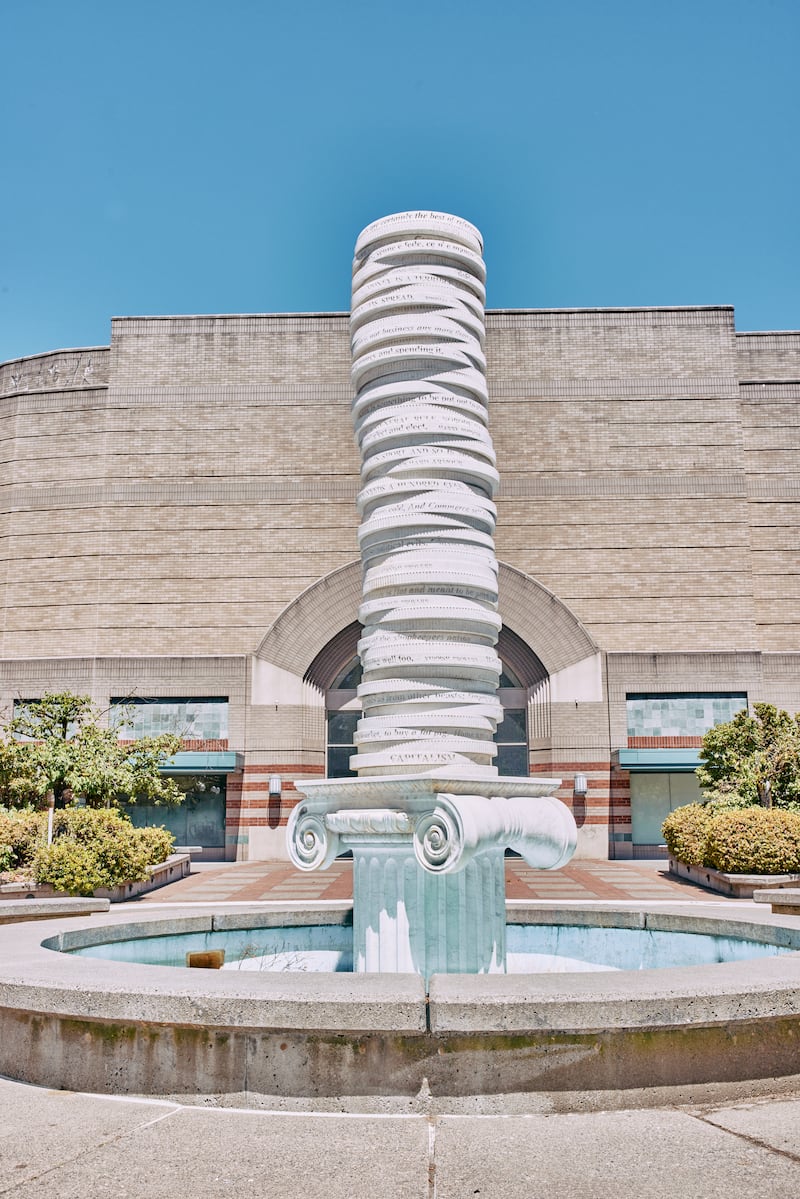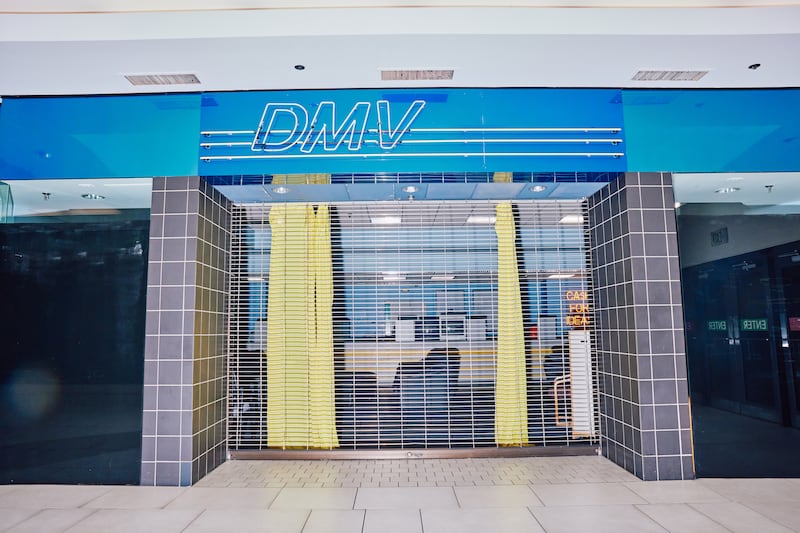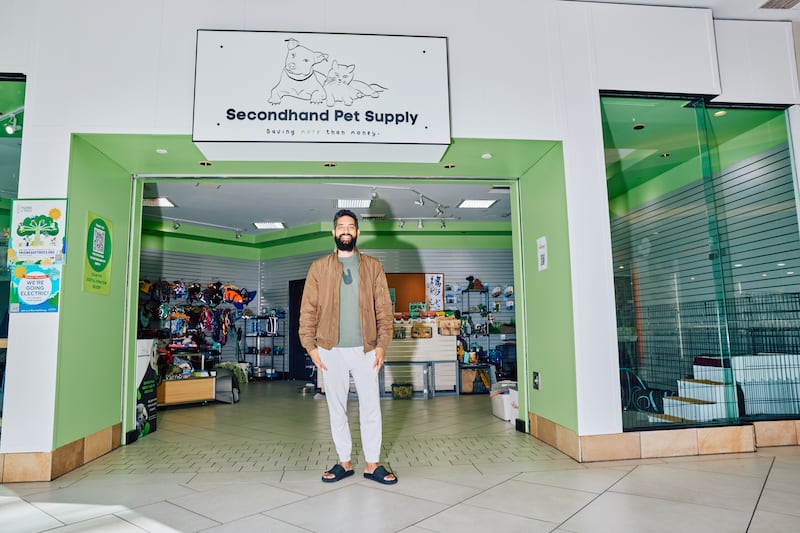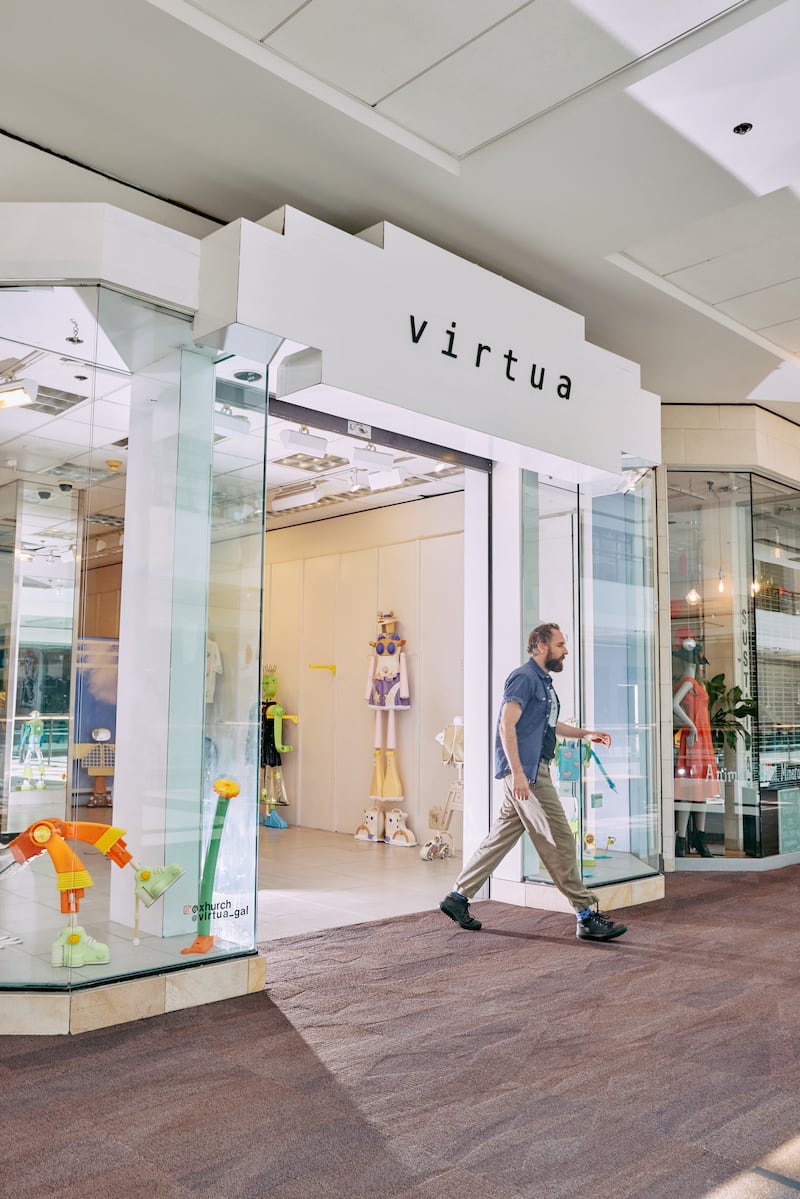Dawn of the Undead Mall (original) (raw)
One Saturday afternoon earlier this month, a group of artists gathered around the dry fountain at Lloyd Center, a marble and concrete sculpture fittingly named Capitalism. The plaza used to sit at the intersection of Nordstrom and Stanford’s Restaurant and Bar, but all that remains now is the fountain, with chipped paint and crispy leaves inside and a giant development notice on a nearby lamppost about a planned two-story multipurpose event center.
But on this day, the fountain also contained an artist named Gili Rappaport.
“Gather around, find your coins,” said Rappaport, the Portland State University graduate student behind the movement art piece: a temporary art installation that doubled as a 30-minute performance. Rappaport strolled the well of the fountain wearing a sheer bubblegum pink overcoat—the outfit came to them in a dream—dropping pennies on the rim for their audience to grab. Once the crowd of about 40 had settled in, Rappaport formally began the piece, which was part of their Art & Social Practice MFA program at PSU.
“For 30 minutes,” they said, “we’re going to transform this fountain, which was a symbol of individual gain, to an expression of the common good.”
One by one, participants said their wishes aloud and tossed their pennies into Capitalism. They wished for ice cream, for compassion, for a free Palestine, and for health and happiness for everyone at the fountain.
“I wish that everything that is in the process of degrading, including this fountain, degrades exquisitely,” said one woman, before crumpling to the ground for effect.
Lloyd Center—opened in 1960 as Portland’s first mall, covered with a roof around 1990, and degrading, but perhaps not exquisitely, for more than a decade—is at a curious and tender point in its life. For at least five years, city officials and mall developers have been wringing their hands over what to do with the 29-acre property smack in the inner Northeast quadrant. (Major League Baseball stadium? Replacement for Keller Auditorium?) Meanwhile, a collection of small businesses, nonprofits and independent artists like Rappaport has claimed it as their own.
In the retail industry, Lloyd is what’s known as a “zombie mall”—physically present but lifeless—as opposed to a true “dead mall.” (Think George A. Romero’s 1978 cult classic Dawn of the Dead, set in a deserted mall during the zombie apocalypse as a comment on the mindlessness of consumer culture.)
Only a handful of national retail brands remain in the mall, including Forever 21, Claire’s, Hot Topic and Barnes & Noble. But as chronicled by outlets, including Oregon Business in 2023, the mall is dotted with shops exhibiting the classic Portland quirk that some thought had gone extinct.
Like the food carts that sprouted in empty parking lots two decades ago, these shops are a direct result of discounted commercial rent. Tenants would not disclose on the record just how cheap lest they offend. Everyone has their own deal, but it’s about 1,000amonth,or50centsasquarefoot.That’sfarlessthanthegoingrateforastudioapartmentintown(1,000 a month, or 50 cents a square foot. That’s far less than the going rate for a studio apartment in town (1,000amonth,or50centsasquarefoot.That’sfarlessthanthegoingrateforastudioapartmentintown(1,464, according to ApartmentList.com).
The result? The owners say the mall is 75% occupied, but they arrive at that number by excluding the hulks that once held anchor stores and including the top floor of offices, which they say are at full capacity. That figure doesn’t pass the vibe test, though. On a recent afternoon, we saw signs of activity in 67 of 135 commercial spaces.
At least half of those are independent art galleries and boutiques—some of them rather strange.
Electronic Music Club has turned the Zumiez dressing rooms into sound booths for laying down vocals for indie-pop tracks. A lady named Chickpea runs a roller-skating school where skaters can practice their footwork around plastic cones for 3anhour.Apuppeteerandretroplaydesignenthusiastrealizedherlongtimedreamofopeninganindoorchildren’splayspace.ShenameditMudland,andfor3 an hour. A puppeteer and retro play design enthusiast realized her longtime dream of opening an indoor children’s play space. She named it Mudland, and for 3anhour.Apuppeteerandretroplaydesignenthusiastrealizedherlongtimedreamofopeninganindoorchildren’splayspace.ShenameditMudland,andfor14 children can play for up to two hours in the “moon garden” with long pillows called “space worms” and foam rocks.

Lloyd Center—Dawn of the Undead Mall MAKE A WISH: Capitalism is a dry fountain built in 1991 in front of the vacant Nordstrom. (Michael Raines)
Artists have a long history of revitalizing blighted neighborhoods. New York City’s SoHo transformed from a bombed-out industrial zone into an arts scene in the 1960s and ‘70s. The same thing happened to Portland’s Pearl District and Central Eastside starting in the 1980s. The resurgence of Lloyd Center reminds PSU art professor M. Michelle Illuminato of 1990s Pittsburgh, where she and other artists repurposed abandoned buildings as performance venues and studio spaces. Illuminato supervised Rappaport’s Find the Penny, Make the Wish and a whole class of students who declared themselves “artists in residence” at the mall this spring.
“The fact that the businesses themselves have left has actually left a precious gap where artists can move in and create a new community here in the mall,” she says. “Some people call this a dead mall. But now that we’ve done this residency, I think it’s become a real, vital community to me now.”
Unlike SoHo or the Pearl, though, this artist community is temporary. Developers say most of Lloyd Center will be torn down over the next decade or two, starting with Nordstrom, to make way for mixed-income housing, retail, restaurants, community spaces, and an ice rink. In the meantime, the artists, the music makers and the dreamers of dreams are enjoying a rare opportunity for low-cost rent in the city center just to experiment—for as long as it lasts.
Katie Shook, the puppeteer behind Mudland, has already extended her lease beyond the original two-month pop-up. Wearing a Pee-wee Herman T-shirt and Saturn earrings, Shook explained that she never thought her moon garden would be a brick-and-mortar until she met one of the mall owners through mutual friends. The pop-up lease was so affordable that she gave it a whirl and launched in March.
Now, she and some of the other tenants help each other out with tables and chairs for events or a ladder if something needs quick repair. The janitor has dropped off stuffed animals at Mudland; Tada Toys across the hall donated surplus inventory. An adorable preschool class regularly walks through the mall to see Tater Swift, the bunny in the window of Secondhand Pet Supply.
“I love the community that is growing. It’s so fun in here,” Shook says. “It’s a real neighborhood.”
On a recent Saturday afternoon, any fun new energy at Lloyd Center remained elusive.
The ice rink where Tonya Harding once learned to skate was a brightish spot, as advanced ice skaters twirled to Joan Jett’s “I Love Rock ‘n’ Roll” and beginners pushed penguin statues for balance. But whole wings of the 1.3 million-square-foot mall were deserted, the hush of the corridors even more jarring because the mind expects a cacophony of chatter, laughter, whining, heels clicking on the shiny floors, perhaps some pop hits piped in. There were no packs of tweens giddy with their first whiff of independence, no movies playing upstairs, no traditional anchor stores.
The nail salon did manicures behind half-closed gates. Entering Barnes & Noble past two attentive uniformed guards felt a little like airport security. The smell of the mall was part Cinnabon, part cleaning solution.
Shoppers could still get a classic Orange Julius at the Dairy Queen, one of only two food court restaurants open that day, along with Chicken Connection. But it’s overpriced and too sweet and gives a terrible brain freeze.
It is worse than you remember.
On the escalator, a boy looked around and let his father have it. “Did you bring me to a fake mall? It’s so empty. And this is the weekend!”
Not only was it the weekend, it was less than an hour after Lloyd Center had served as the end point of the Rose Festival’s Grand Floral Parade. The whole Rose Festival Court had just breezed through in street clothes and full hair and makeup, chatting about proper “elbow, elbow, wrist, wrist” waving techniques and sipping cold drinks as their handlers whisked them to the parking garage.
When Brittany Santiesteban arrived for work at Secondhand Pet Supply that morning, the parking structure was packed with cars, a vibrancy she hadn’t seen since she was a teenager. Santiesteban, 34, grew up in West Sylvan and remembers the mall’s heyday fondly.
“It was always, like, the fun thing to come over here and actually be around people of color,” says Santiesteban, who is Black. “I remember coming over here to meet people and eat and just hang out. It was so lively, so much fun. I have a lot of really great memories from that. So it’s really sad to see it like this.”

Lloyd Center—Dawn of the Undead Mall LET'S CONNECT: Only a few restaurants remain in Lloyd Center's food court, including Chicken Connection. (Michael Raines)
All those cars in the garage? They weren’t shoppers. They were paradegoers who just wanted a convenient place to park.
Santiesteban saw them come in to cool off in the air conditioning, use the restrooms, go on a futile search for food, and leave empty-handed. It was a missed opportunity, she says. “If you have plans to, like, tear it down and all of that, that doesn’t mean that you’re not intentional in the meantime. Because there’s value here now.”
A retro Lloyd Center is the cover girl of the 2022 book Meet Me by the Fountain: An Inside History of the Mall by New York City architecture critic Alexandra Lange. One of her central arguments is that malls are meant to be malleable and, actually, have had to reinvent themselves about every 10 years.
There are three culprits behind the death of malls, Lange writes: online shopping, the decline of department stores, and because America is overmalled.
Lloyd Center has been on shaky ground for a decade—it lost Nordstrom in 2015, Sears and Marshalls in 2018, and other national chains quickly followed suit. News coverage at the time (“Last Christmas at Lloyd Center?” WW, Dec. 4, 2019) cited safety concerns and brazen shoplifting for the mass exodus. Meanwhile, across the river and over the hills in suburban Washington County, Washington Square announced in April it had reached full capacity with the arrival of five new tenants, including Moleskine and Arc’teryx.
But Lange sees Lloyd’s collapse as an asset.
“More changes are on the table than when something is limping along,” she says. “It feels like people are willing to make radical moves—like throwing spaghetti at the wall—and that can lead to good things, though not without some failures along the way.”
Dennis Henderson is Lloyd Center’s director of operations. He started at the mall in 1979 as an apprentice engineer and worked his way up to chief engineer and tenant construction coordinator to his current position, which he categorizes as “paper-pusher.”
Other than needing a little hand-holding about things like permitting and fire marshal rules, he says the new local tenants are easier to work with than the national chains and their tangles of lawyers, architects and executives. He prefers the Lloyd Center of decades past, though, when it was bustling with shoppers, stores and events.
“Before would probably be better than right this moment,” Henderson says, “but I can definitely see what it’s going to be. Just looking at drawings, I can visualize what that tenant space is going to look like. I’m really excited about it.”
The tenants who have moved in include a few artists whose names you might recognize. Portland photographer Robbie Augspurger (clients: Balenciaga, Adidas, Old Spice, Polaroid) did an installment of his nostalgic and funny “Glamour & Headshots” series at the mall in December, complete with soft-focus ocean backgrounds and cheesy props like sunglasses and a Greek column. WW freelance photographer Michael Raines started a similar portraiture project there in 2022 called Family Photo Studio.
Larry Peace-Love Yes, who has had work exhibited at New York’s Museum of Modern Art, moved his rainbow-colored 2022 installation Everyone on This Planet Is Family from the airport to the mall. Jason Kreher, former creative director of Wieden+Kennedy, turned the old DMV into a creative coworking space and just kept the name and government signage.

Lloyd Center—Dawn of the Undead Mall CREATIVE LICENSE: The former creative director of Wieden+Kennedy has turned the abandoned DMV into a coworking space. (Michael Raines)
Lange has been tracking Lloyd Center’s small-business takeover. She has seen nothing like what’s happening at Lloyd Center in contemporary mall redevelopment. The closest analogy to Lloyd Center she could come up with was 1970s “festival marketplaces” like Boston’s Faneuil Hall.
She also cautions that while what’s happening at Lloyd Center feels like it comes from the grassroots level, it’s actually partly the result of a feasibility study produced for Seattle-based developer Urban Renaissance Group by HR&A, a national company that also advised on The High Line in New York City. (“They’re very posh in the urbanism world,” Lange says.)
Tom Kilbane is managing director of Urban Renaissance Group, which co-owns the mall with KKR Real Estate Finance Trust. KKR foreclosed on Lloyd Center in 2021. Kilbane confirms that HR&A did a feasibility study for Lloyd Center, but would not reveal the content.
The artistic energy in Lloyd right now is indeed organic, he says.
“The early tenants that came in just started to tell their friends, and word kind of got out,” Kilbane says. Musique Plastique record store was first, followed quickly by Floating World Comics. “We liked what was happening, and we kind of went with it.”
The biggest issue URG and KKR had when they took over in 2021 was crime (though Kilbane calls it “bad behavior in the mall”). The immediate neighborhood feels dodgy. There is a cluster of people living in tents across Northeast Multnomah Street at Holladay Park. In the early evening of June 8, a steady stream of people crossed over to Lloyd Center. One was swinging a sword.
The company has beefed up security, including hiring a new director of security and raising wages for guards.
Now, misbehavior is dealt with swiftly, and feedback from tenants and shoppers has been very positive, Kilbane says. Reporting largely confirmed this. One tenant appreciated management’s efforts at cleanliness and security and said, “They’re keeping the mall really nice, as if it was full of businesses.” The security team is actually so efficient that the PSU artist group had to give advance notice every time it did an art event at the mall so it didn’t get booted out.
Still, some business gates remain half closed.
Not long after KKR foreclosed on Lloyd Center, WW floated six ambitious ideas for how to reactivate one of the largest commercial footprints in the city (“Tomorrowlloyd,” Nov. 17, 2021). Since then, KKR and URG have moved down a path of replacing the mall with a residential and commercial street grid. But the timing remains uncertain.
Kilbane would not comment on the development status of the mall, other than to refer to the plan his company released to the city in September and public records. Enthusiasm for a new entertainment venue at Northeast 9th Avenue and Multnomah Street seemed to pulse through a May 2 Portland Design Commission meeting, according to a memo obtained by WW. One design commissioner said the architecture “must be iconic” while another encouraged developers to take inspiration from the Centre Pompidou in Paris and be a “disruptor of the context.” (The renderings look like a classy, modern venue with a cool ecoroof, but not particularly Parisian.)
URG has said Lloyd Center will remain open for business throughout the planning and long-term, phased redevelopment process. As for how long that will be, Kilbane would not give a timeline but did point to Slabtown as a possible point of comparison. The 18-acre Northwest Portland neighborhood’s master plan was drawn up in 2012 and is just now wrapping up. Lloyd Center is 29.3 acres.
Jason Leivian, owner of Floating World Comics, plans to enjoy the ride as long as it lasts.
“I’ll be at Lloyd Center as long as the rent is affordable,” Leivian says. “They said they would do construction in phases and that could get noisy. If that’s a problem, then I’ll probably have to move in the next two to five years. But who knows how quickly this development will happen?”
Floating World moved to the former Torrid space two years ago after spending 16 years in Old Town Chinatown. His space is bigger and sales are better in Lloyd, Leivian says. No one appears to be raking in cash or customers in any traditional sense, though.

Lloyd Center—Dawn of the Undead Mall IN THE MARKET: Secondhand Pet Supply owner Michael Santiesteban attracts most customers by posting items on Facebook Marketplace. (Michael Raines)
Mudland is considering applying for grants to bolster its business model and will only “probably” be able to sustain itself this coming fall. Zero shoppers came into Secondhand Pet Supply during a 30-minute interview one Saturday afternoon. Owner Michael Santiesteban says he mostly attracts customers by posting items on Facebook Marketplace and gets substantial foot traffic only during mall events.
Even a special event wasn’t enough to lure many customers, though, to the Spot Market, a two-day craft fair in early May. “Today does not seem to be a bath day,” one aromatherapy vendor quipped as her soaps, spritzes and bath bombs went untouched.
“It’s all relative,” Leivian says. “Even a mostly empty mall is still pretty full to us, compared to how some neighborhoods go.” One hundred shoppers is nothing to sniff at, he says. “It just looks empty because it’s a million square feet.”

Lloyd Center—Dawn of the Undead Mall HALL PASS: On a recent visit, WW saw signs of activity in 67 of the 135 commercial spaces. (Michael Raines)
Floating World was in Lloyd Center’s first wave of small-business tenants, Leivian says, along with businesses such as Musique Plastique record store, Mortal Emblem tattoo parlor, and Dreem Street T-shirts. They jokingly called themselves the Lloyd Arts District. All of those businesses have since moved on from Lloyd Center except for Floating World.
Matt Henderson is the director of Virtua Gallery, a musician, and a longtime member of Portland’s avant-garde art scene. Though Virtua Gallery was only supposed to be a holiday pop-up to showcase his annual exhibit of twisted Nativity scenes (alien Nativity, virtual reality Nativity, etc.), Henderson is still there. He loves having exhibition and studio space, plus he’s hosted four concerts in the stockroom in the back.
On the same day as Rappaport’s Find the Penny, Make the Wish, a modest group of concertgoers came to see some experimental jazz in the former stockroom of Lady Foot Locker.
“Park in the covered garage directly next to Barnes & Noble,” read Henderson’s directions to attendees. “When entering the mall, head straight past Carmel Corn and take a right at Golden Horn (don’t forget to touch the genie lamp with your mind as you round the corner).”
Performers stood on a small wooden platform that was used for ukulele lessons in the interim between Lady Foot Locker and Virtua. Malls are malleable.

Lloyd Center—Dawn of the Undead Mall VIRTU-O-SO-FUN: Artist Matt Henderson (pictured) started Virtua Gallery, which is currently presenting work by Ryan Boyle, also known as "Collect Call." (Michael Raines)
A three-piece experimental jazz fusion band called Naked Moon performed first. The crowd of about 20 sat on the floor. The drummer wore exaggerated orange eyeshadow and alternated between playing the instrument with actual drumsticks and small pink pompoms. Disassembled shelves were stacked vertically in one corner while a naked white plastic mannequin surveyed the scene from the opposite site of the venue. The show had to wrap up by 9 pm—the mall gave it a two-hour extension past closing time, but nixed Henderson’s original idea of staging the concert on the ice rink.
“The ‘Keep Portland Weird’ crowd really wants to see this total, transformative, exuberant artist takeover of the mall,” Henderson says. “It is exciting. I do want to commend the mall for letting it go this far, but it could go a lot further.”